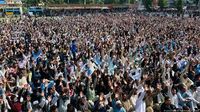After nearly a week of violent unrest that shook Pakistan-occupied Kashmir (PoK), a breakthrough agreement between protest leaders and the Pakistani government has brought a tense calm to the region. The deal, signed late on October 4, 2025, follows days of mass demonstrations, deadly clashes, and a communications blackout that left at least 10 people dead and hundreds more injured, including both civilians and police officers, according to multiple reports from Hindustan Times and PTI.
The protests, which began on September 29, were organized by the Jammu Kashmir Joint Awami Action Committee (JKJAAC)—also known as the Awami Action Committee (AAC)—a civil rights alliance advocating for economic and political reforms in PoK. Protesters, many of whom traveled from towns across the region, converged on the capital, Muzaffarabad, voicing frustrations that had simmered for years. Their grievances ranged from demands for cheaper wheat and electricity to calls for more transparent governance and better healthcare. As negotiations initially faltered, the situation spiraled into violence, resulting in the deaths of seven civilians and three police officers, as confirmed by local police sources cited by DW.
The unrest was not the first of its kind. Similar protests erupted in 2024, leading to four fatalities. While some concessions were made then, most promises remained unfulfilled, leaving residents wary of government assurances. This time, however, the pressure was intense and the stakes higher, with the region effectively shut down and daily life disrupted for thousands.
At the heart of the protesters’ demands was a 38-point charter that called for sweeping changes. These included an end to what demonstrators described as “lucrative benefits” for the political elite—such as free electricity and expensive official vehicles—alongside practical improvements like the phased installation of MRI and CT Scan machines in every district, and the creation of new educational boards. Protesters also demanded the abolition of 12 assembly seats in PoK reserved for Kashmiri refugees living in Pakistan, a system widely seen as a lever for Islamabad to maintain indirect control over the region’s politics. “The people of PoK have long felt disenfranchised,” a protest leader told PTI, capturing the mood of the crowds.
The government’s response, at first, was forceful. Security forces clashed with demonstrators, leading to hundreds of injuries and widespread anger. As the crisis deepened, Prime Minister Shehbaz Sharif dispatched a high-powered delegation led by former premier Raja Pervaiz Ashraf to Muzaffarabad. Over two days, the delegation engaged in marathon negotiations with JKJAAC leaders. The talks concluded just before midnight on October 4, with Pakistan’s Minister for Parliamentary Affairs Tariq Fazal Chaudhry announcing the agreement. “Negotiating delegation has signed the final agreement with the Action Committee.... The protesters are returning to their homes. All roads have been reopened,” Chaudhry declared on X (formerly Twitter), according to PTI.
The final agreement, a 25-point document, addresses many of the core grievances raised by the protesters. Highlights include compensation for the families of those killed, the registration of terrorism cases related to the violence, and a significant federal investment of PKR 10 billion to overhaul PoK’s electricity system. The government also pledged to release funds for health cards within 15 days, enabling free medical treatment for residents, and to provide MRI and CT Scan machines in every district in a phased rollout. In education, two new intermediate and secondary boards will be established in Muzaffarabad and Poonch divisions, aiming to decentralize and improve local oversight.
Administrative reforms are also part of the package. The size of the PoK cabinet will be reduced to 20 ministers and advisors, with a corresponding reduction in administrative secretaries. Some government departments will be merged to streamline operations. In a nod to infrastructure development, the agreement calls for feasibility studies into the construction of two tunnels in Neelum Valley, as well as steps toward building an international airport in Mirpur. Additionally, taxes on property transfers will be brought in line with those in Punjab and Khyber Pakhtunkhwa provinces within three months.
For many, the agreement represents a hard-won victory. Shaukat Nawaz Mir, a leader of the civil rights alliance, publicly thanked the government, saying, “I am grateful to the Prime Minister Shehbaz Sharif and the whole of Pakistan for understanding our problems and agreeing to resolve them,” as reported by DW. He urged protesters to disperse and return home, signaling an end to the immediate standoff.
Yet, skepticism lingers. Alliance leaders recall the unfulfilled promises following last year’s unrest and have called for vigilance to ensure this agreement is implemented. To that end, a monitoring committee has been established, tasked with overseeing the rollout of reforms and ensuring that authorities remain accountable. “Public interest and peace are our priorities, and we will continue to serve Azad Kashmir,” Prime Minister Sharif assured in a statement.
The unrest and its resolution have not gone unnoticed outside Pakistan. India’s Ministry of External Affairs described the turmoil as a “natural consequence of Pakistan’s oppressive approach and systemic plundering of resources” in the region. India reiterated its long-standing position that PoK is under Pakistan’s “forcible and illegal occupation” and called on the international community to hold Pakistan accountable for alleged human rights violations.
The political and historical backdrop to these events is complex. Since their independence from Britain in 1947, both Pakistan and India have claimed the Himalayan territory of Kashmir in full, but each controls only a portion. The region has been the flashpoint for multiple wars and remains a symbol of unresolved conflict. For residents of PoK, the recent protests reflect not just local grievances but decades of frustration over economic hardship, political marginalization, and a sense of being caught in the crossfire of larger geopolitical disputes.
For now, the streets of Muzaffarabad and other towns in PoK are quiet. Roads have reopened, the communications blackout has been lifted, and a fragile peace holds. Whether the 25-point agreement will mark a turning point or simply another chapter in a long saga remains to be seen. What’s clear is that the people of PoK have made their voices heard—and the world is watching to see what comes next.




